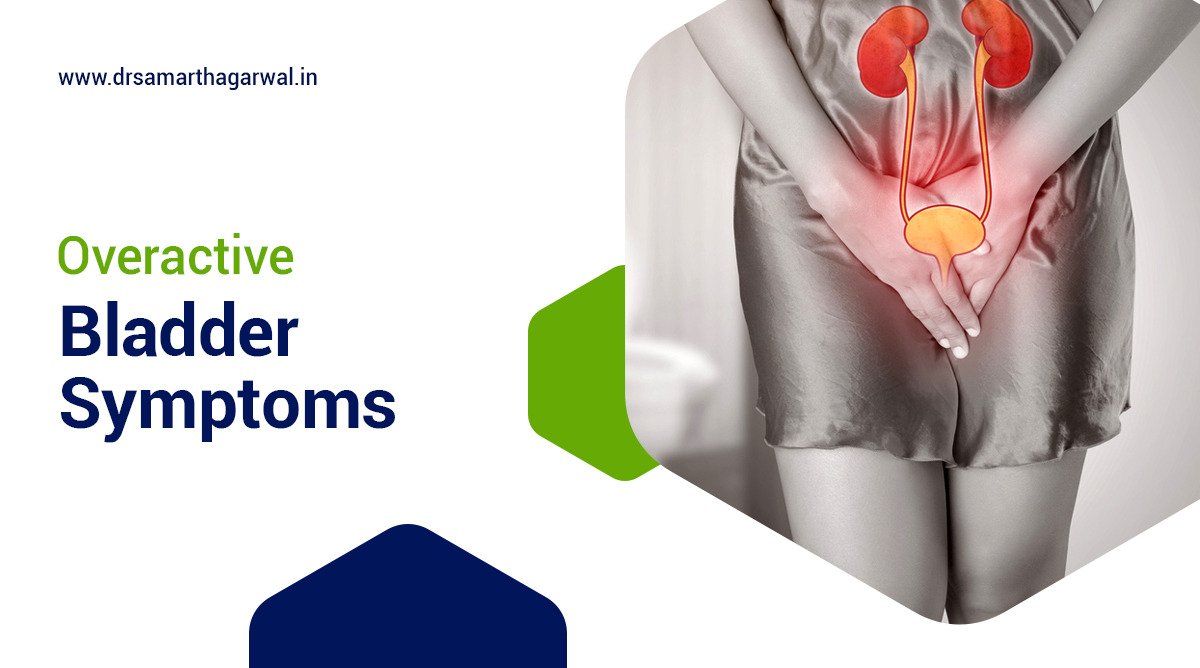What are the common symptoms of overactive bladder (OAB)?
Patients with overactive bladder symptoms may experience a sudden, difficult-to-control urge to urinate, urgency incontinence, frequent urination (eight or more times in 24 hours), and nighttime urination.
Common symptoms of overactive bladder (OAB):
- Constant sensation of needing to urinate, a common symptom of OAB, may cause significant discomfort and affect daily activities.
- Incontinence
- Frequent urination
- Frequent nighttime urination (two or more times)
This condition can significantly impact daily life, causing embarrassment and social limitations due to symptoms such as a sudden urge to urinate and pressure on your bladder. Various factors, including neurological disorders, diabetes, urinary tract infections, hormonal changes, and bladder-related conditions, may contribute to OAB symptoms.
While some medications or lifestyle choices can exacerbate symptoms, effective treatments, such as pelvic floor exercises, bladder training, and medications, can help manage OAB.
Seeking prompt medical attention for an accurate diagnosis and tailored treatment plan is crucial for individuals experiencing symptoms of overactive bladder.
What are the causes and factors contributing to overactive bladder?
Overactive bladder may result from conditions such as abdominal trauma, infection, nerve damage, and certain medications or fluids, impacting bladder function.
Overactive bladder (OAB) is characterized by symptoms like urinary urgency, incontinence, and frequent urination. Factors contributing to OAB include abdominal trauma, infections, nerve damage, and medications. The detrusor muscle, responsible for bladder contractions, is often affected. Management involves behavioral changes, medications, and nerve stimulation.
OAB can affect various demographics, being common in those over 65. Treatment helps improve symptoms, but OAB typically doesn’t resolve on its own. Medications like anticholinergics, behavioral strategies, and surgical options may be employed. It’s crucial to address underlying conditions contributing to OAB, emphasizing personalized care for optimal outcomes in the treatment of overactive bladder.
Understanding the Role of Bladder Muscles in OAB
The detrusor muscle, located in the bladder walls, contracts during urination to expel urine, and its dysfunction can contribute to an overactive bladder (OAB).
The detrusor muscle, composed of longitudinal and circular smooth muscle fibers, plays a crucial role in the management of overactive bladder (OAB). Its primary function involves contracting during urination to facilitate the expulsion of urine.
The detrusor muscle’s interwoven orientation allows the bladder to stretch in response to urine presence. Under autonomic control, the parasympathetic nervous system stimulates muscarinic receptors, triggering detrusor muscle contraction for urination. Complications affecting the detrusor muscle, such as pelvic surgery, may lead to bladder dysfunction and contribute to the pressure on your bladder.
Understanding and addressing detrusor muscle activity are crucial in therapeutic approaches, including bladder retraining and pelvic floor muscle training, which aim to modulate detrusor contractions. Pharmacological treatments often target the detrusor muscle to achieve relaxation, alleviating OAB symptoms. Overall, insights into the detrusor muscle’s anatomy, function, and control mechanisms are fundamental for effective interventions in the context of OAB.
Potential Triggers for Overactive Bladder
Overactive bladder (OAB) is a common urologic condition, often triggered by factors such as neurological disorders, diabetes, urinary tract infections, and bladder obstruction.
Overactive bladder (OAB) is a prevalent urologic condition affecting about 33 million people annually. The bladder’s intricate coordination involving nerve signals and muscle contractions for proper emptying can be disrupted, leading to OAB.
Neurological disorders like multiple sclerosis, spinal cord injury, and Parkinson’s can contribute to OAB symptoms, emphasizing the connection between OAB and nervous system conditions (NCBI). Diabetes and its impact on bladder function, along with potential complications like kidney problems, are significant triggers
OAB treatment options encompass pelvic floor exercises, bladder training, fluid control, medication, sacral nerve stimulation, and surgery. Lifestyle modifications, like managing fluid intake and quitting smoking, can be helpful.
How is overactive bladder diagnosed?
To diagnose overactive bladder, healthcare professionals typically start with a comprehensive health history, including questions about urinary patterns. This involves physical examinations, neurological assessments, and specific tests. Tests commonly used include urinalysis to identify infections or inflammation, postvoid residual volume assessment to check complete bladder emptying, and additional evaluations by urologists or urogynecologists.
A doctor may also assess contributing factors through tests like pressure studies to understand bladder function fully. The results guide the development of a personalized treatment strategy.
In Siliguri, you can consult Dr. Sidharth Agarwal if you believe you are having urinary issues.
How is the overactive bladder treated?
Overactive bladder is a condition characterized by frequent and irresistible urges to urinate, often resulting in urine leakage. Treatment for overactive bladder may involve medications, lifestyle changes, behavioral therapies, and surgical interventions.
The first-line medications for OAB include anticholinergics, which act by relaxing the bladder muscle. Other drugs used to treat OAB include beta-3 agonists, tricyclic antidepressants, and selective serotonin reuptake inhibitors. In cases of severe bladder overactivity, anti neurokinin-1 receptor antagonists and muscarinic receptor agonists may be considered by your doctor.
Lifestyle changes, such as weight loss, reducing caffeine intake, and practicing good posture, can help alleviate symptoms of overactive bladder. Bladder training, involving scheduling regular urination breaks, can also be beneficial.
In some cases, surgical options, including bladder augmentation, bladder replacement, and artificial urinary sphincters, may be considered for patients with severe symptoms.
It is essential to work closely with a healthcare provider to determine the best treatment plan for each case of overactive bladder, as individual responses and adverse effects can vary. Medication and other therapies should be tailored to the patient’s specific symptoms, medical history, and individual needs.
Is overactive bladder a common issue in specific demographics?
Overactive bladder (OAB) is a prevalent condition affecting both men and women, with an estimated prevalence of 16.5%, significantly impacting daily activities and quality of life.
Although the prevalence is similar in both men and women, there are sex-specific differences in individual symptoms and their impact. OAB can coexist with benign prostatic hyperplasia in men, also exacerbating its effects and increasing urinary symptoms. The condition’s prevalence increases with age, with frequency being the most commonly reported symptom, along with a sudden urge to urinate being indicative of the syndrome.
Despite its impact, the level of bother and quality of life associated with OAB highlight the need for improved diagnosis and treatment, with a focus on managing symptoms and causes effectively. Understanding demographic factors, including age and sex, is crucial for addressing the symptoms of an overactive bladder and lessening the burden it imposes on affected individuals.
Can overactive bladder syndrome go away?
Overactive bladder syndrome doesn’t go away on its own, requiring interventions for effective overactive bladder treatment. If untreated, symptoms can worsen, affecting bladder control and pelvic floor tissues.
Despite lacking a cure, symptom management through lifestyle adjustments and medical interventions, including surgery in severe cases, is emphasized. Discontinuing treatment may lead to recurring symptoms, highlighting the importance of ongoing care.
Factors influencing remission include resolution of symptoms, tolerance of unresolved symptoms, side effects, and treatment effectiveness. Medical guidance is essential to address overactive bladder comprehensively, with a tailored approach to overactive bladder treatment necessary for effective management.

Celebrate recovery from Urinary Problems with Dr. Samarth Agarwal




